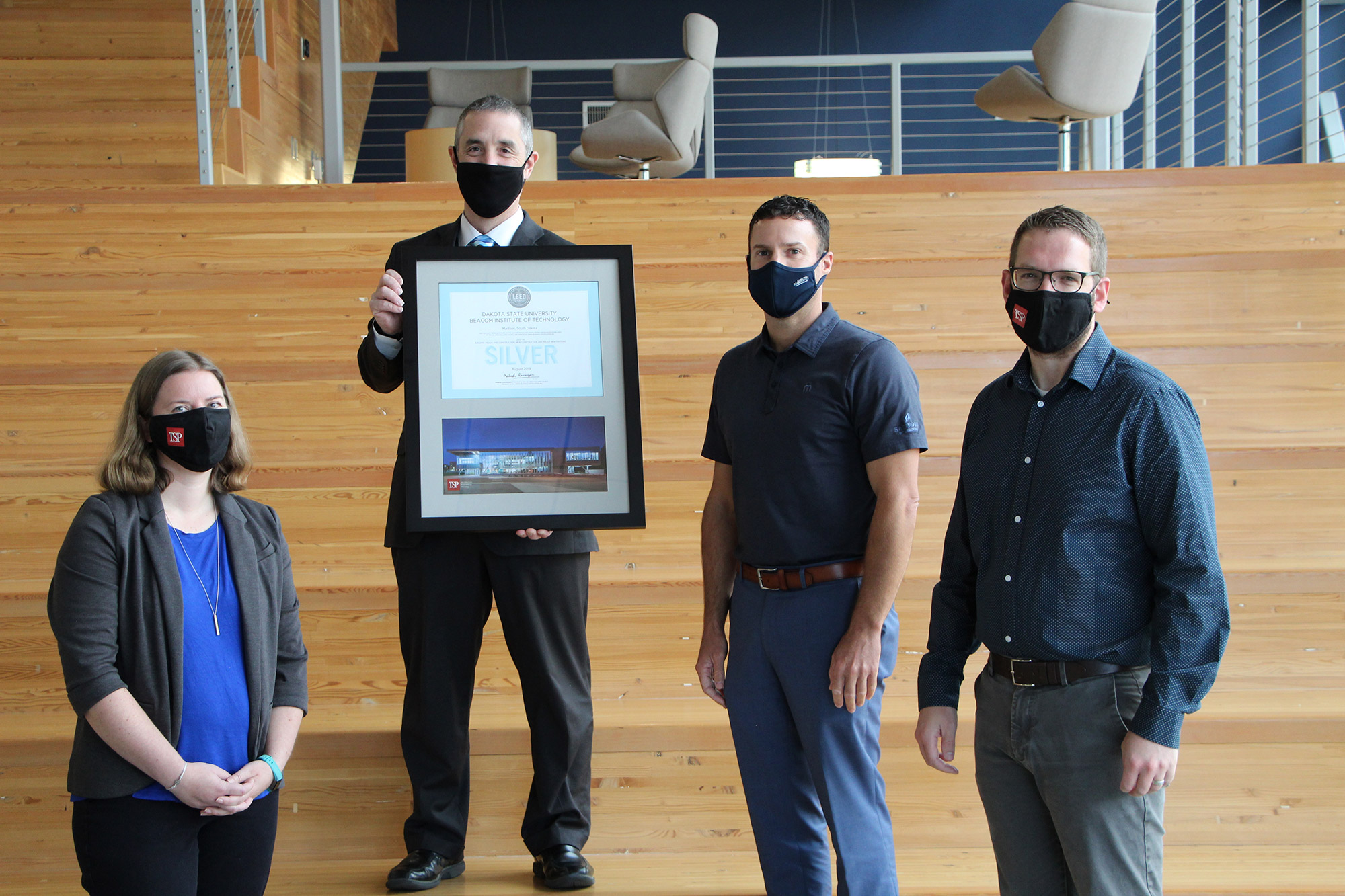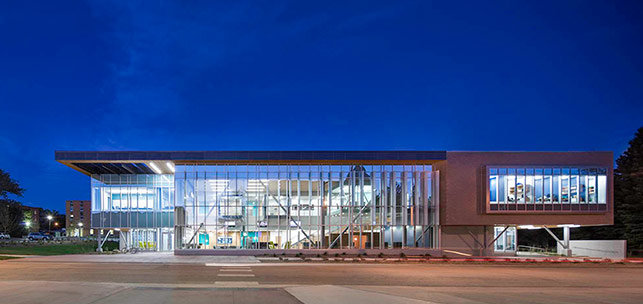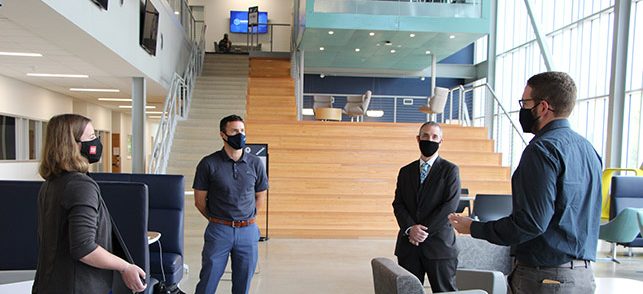MADISON, S.D. – A Dakota State University building designed with both beauty and energy efficiency in mind has received a prestigious honor from the U.S. Green Building Council: LEED Silver certification.
The 31,300-square-foot Beacom Institute of Technology is the first South Dakota Office of the State Engineer project to receive the award after being designed under the LEED organization’s newest sustainability guidelines.
LEED, which is an acronym for Leadership in Energy & Environmental Design, provides a point system to score “green” building design and construction. It includes five basic areas: sustainable sites, water efficiency, energy and atmosphere, materials and resources, and indoor environmental quality. Buildings are awarded points based on the extent various sustainable strategies are achieved.
The LEED Silver award was announced earlier this year, but an official ceremony was delayed because of Covid-19 restrictions. The presentation took place Wednesday morning, Oct. 7, 2020, at the Beacom Institute of Technology, Washington Avenue and Seventh Street NE in Madison. Participants included Dr. Pat Engebretson, dean of The Beacom College of Computer and Cyber Sciences, Stacy Krusemark, vice president for Business and Administrative Services, and TSP, Inc. architects Michelle Klobassa and Chase Kramer. TSP designed the Beacom Institute of Technology in partnership with SmithGroup.
TSP is a 90-year-old multidisciplinary architectural, engineering, planning, and interior design firm with offices in Sioux Falls, Rapid City, and Watertown, S.D.; Rochester, Minn., and Omaha, Neb. SmithGroup has 15 offices across the United States.
In 2018, Beacom Institute of Technology also received an Honor Award and the People’s Choice Award from AIA South Dakota, a professional organization for architects. The Oct. 7 LEED presentation date was chosen to coincide with Energy Efficiency Day, which promotes cutting pollution, saving money, and creating jobs.
“TSP and SmithGroup’s focus on innovative design and construction align perfectly with the mission and practices of Dakota State. We are honored that the first new academic building on our campus in 30 years reflects these principles,” said Stacy Krusemark, vice president for Business and Administrative Services.
Construction of the $11.4 million building started in June 2016, and it opened in August 2017. Students from all programs of study attend almost 150 classes in the Beacom each academic year.
The Beacom Institute of Technology was a landmark project for DSU, which consistently ranks among the country’s top universities for its computer and cyber security programs.
TSP designs all its buildings to be as energy efficient as possible within a client’s budget, Kramer said. Beacom Institute of Technology, however, followed LEED standards to a high degree and was particularly recognized in the areas of innovation and optimized energy performance.
“It’s not all about the heating and air conditioning systems,” Kramer said about designing a green building. “It’s a recognition that buildings consume a huge percentage of the energy we use on the planet, and anything we can do to reduce that, we do, including using sustainable materials and passive strategies for heating and cooling load mitigation.”
TSP’s efforts were enhanced by Dakota State University’s use of greener cleaning products and avoiding harsh chemicals. DSU also approved a reduction in its parking lot standards for the facility to encourage students to walk and bike to class.
“The energy efficient features of the Beacom Institute of Technology are not only visually appealing but ensure that DSU can be responsible with our resources, both financial resources and those of the world around us,” Krusemark said.
Only LED lights were specified on the project, eliminating the use of lamps with mercury or other harmful materials, Kramer said. The interior lighting scope also includes task lighting in offices and study areas, giving users flexibility in the lighting levels they desire, a key aspect of LEED’s indoor environmental quality guidelines.
Some of the requirements affected the construction process. Low-emitting materials were used to reduce odors from building products. Thermal comfort was taken into consideration, allowing people to adjust thermostats in the office spaces to their own satisfaction. Even the landscape has a deliberate green aspect, with a reduction in water consumption through native plantings, Kramer said. LEED credits were awarded since the landscape was designed with no irrigation system, and water use in the building also was reduced via low-flow fixtures and sensors.
One of the Beacom Institute of Technology’s focal points is seen immediately upon entering. The bleacher-like stairs to the second floor were constructed with a salvaged wood product reclaimed from solid and glu-laminated wooden beams in deconstructed old buildings in the Pacific Northwest, Kramer said. They then were manufactured into engineered wood panels for use as interior cladding.
The building also was situated on the land for optimized energy performance. Glass fins block low, glaring sunlight from the west, reducing the need for air conditioning during the summer months, Kramer said. A frit, or applied opaque pattern, was added to the glass windows about 10 feet high. It reduces glare yet maintains a transparent look to the windows for those passing by.
CAPTION: TSP architects Michelle Klobassa (left) and Chase Kramer (right) present the LEED Silver certificate for the Beacom Institute of Technology to Dakota State University’s dean of The Beacom College of Computer and Cyber Sciences, Dr. Pat Engebretson. Also present for the event, held on Energy Efficiency Day (Oct. 7) was Stacy Krusemark, vice president for business and administrative services.



